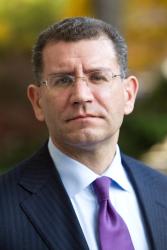

12:30 pm EST - 2:00 pm EST
Past Event
12:30 pm - 2:00 pm EST
1775 Massachusetts Ave., NW
Washington, DC
On December 2, 2009, the Saban Center for Middle East Policy hosted a policy discussion with Yaroslav Trofimov, a journalist from the Wall Street Journal, and the author of The Siege of Mecca: The Forgotten Uprising in Islam’s Holiest Shrine and the Birth of Al Qaeda. Bruce Riedel, a Senior Fellow in the Saban Center, and author of The Search for Al Qaeda: Its Leadership, Ideology, and Future, also provided insights. Kenneth Pollack, Director of the Saban Center, moderated the discussion. The conversation centered on Trofimov’s book, detailing the siege of Mecca and the repercussions of the events on the modern-day battle with Al Qaeda.
The discussion recounted the details of what led to and occurred during the 1979 siege: On November 20, 1979, a group of seven hundred rebels entered the Grand Mosque in Mecca and began to open fire. They took over the mosque and the seven minarets, which gave them effective control of the entire downtown of Mecca. The rebels were led by a former corporal of the Saudi National Guard, Juhayman al-Uteybi.
Uteybi had been active in the Islamic revival that was launched a few years before the siege. The aim of the movement was to start reversing the modernization that had occurred in Saudi Arabia. Uteybi and his followers were upset with Western teachers in Islamic universities, women on broadcast television and other forms of media, and the spread of television. At the University of Medina, he encouraged the youth to join his cause and practice a much more rigorous form of Islam.
Uteybi was especially inspired by one student at the University of Riyadh, Mohammed Abdullah al-Qahtani. Uteybi started to believe, like many others, that Qahtani was destined to become the Mahdi. According to Islamic scripture, the Mahdi—a messiah—would come to earth to redeem the world at the end of the days. The young student seemed to fit the many characteristics of the Mahdi, and it was reported that many people were having dreams and visions that he would rescue the Islamic world. The Saudi authorities grew quite alarmed by these statements and launched a massive arrest in 1978. Many of the members of the movement supporting Qahtani were taken into custody. However, the Saudi government believed that the group would not spread harm to the kingdom and ultimately released Qahtani and others.
On November 20, the rebels were able to smuggle their weapons into the Grand Mosque by hiding them in coffins and driving three trucks of weapons into the basement. Once the mosque had been conquered, the rebels urged the worlds’ Muslims to rise up and confront the infidels. The Saudi government immediately shut down all phone lines from the kingdom to the international world.
The news of the siege in Mecca broke in Washington twenty-four hours later at a State Department briefing. At the time, the United States was involved with the Iran hostage crisis, which initially led American officials to believe that Iranian fundamentalists were responsible for the attack. In response, the Iranians accused the United States of starting the siege themselves to defile the holiest shrine of Islam. American embassies throughout the Islamic world were consequently attacked.
In attempts to surround the mosque, the Saudi Army came under intense fire from the rebels in the minarets. On only the second day of battle, the Saudi soldiers lowered their weapons and refused to fire upon the mosque because the Islamic scripture says that Mecca is an area of peace. To continue the fight against the rebels, the Saudi government had to secure an Islamic decree—a fatwa—from Muslim clerics. The clerics decided Qahtani was a false Mahdi and settled on a historical compromise with the government. The clerics agreed to let the government storm the mosque, in exchange for the halt of modernization in the kingdom; the clerics demanded that women be removed from television, alcohol laws be strictly enforced, and government funding be appropriated towards cleric-missionaries throughout the Islamic world. This compromise created an infrastructure which allowed Al-Qaeda militants to breed throughout the Arab world.
Once the government was armed with the fatwa, the Saudi army tried to storm the mosque again. However, the rebels were well-trained; some were trained snipers and many others were former officers of the Saudi Arabia National Guard. After a week of heavy fighting, the government managed to secure the surface of the Grand Mosque. The rebels fled to the basement, a labyrinth of halls that would allow them to easily ambush the Saudi Army. The Saudi government appealed to the French government for aid; the French sent a Special Forces group to quell the violence. The Special Forces used poisonous gas against the rebels in the basement, killing Qahtani, and after two weeks, the Saudi army was able to extract the remaining rebels from the basement, including Juhayman al-Uteybi. The rebels captured in the mosque were either publicly beheaded in January 1980 or killed in secret.
Two weeks after the end of the siege, the Soviet Union invaded Afghanistan. The Saudi and U.S. government realized that the broader movement in Saudi Arabia would be valuable in the war against communism. Within a month of the siege, the supporters of the rebels were shipped to Afghanistan to help fight against the Soviets. Though Osama bin Laden was not an original supporter of the rebels, he was angry about how the Saudi government behaved during the siege and the subsequent desecration of the mosque. He later said: “Juhayman made a mistake, but the Saudi government committed a crime.” The ideals that Juhayman al-Uteybi and the rebels defended in the siege of Mecca were adopted by the next generation of jihadists in Afghanistan and the Islamic world.


Vanda Felbab-Brown
April 11, 2024

Vanda Felbab-Brown
March 28, 2024

Suzanne Maloney
March 1, 2024